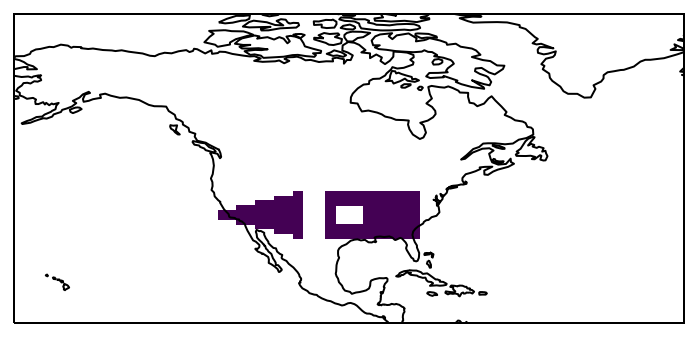Note
This tutorial was generated from an IPython notebook that can be downloaded here.
Create your own region¶
Note
In version 0.5 the Regions_cls has been renamed to Regions and it’s call signature has changed. All arguments (except outlines) are now optional.
Creating own regions is straightforward. Import regionmask and check the version:
import regionmask
regionmask.__version__
'0.5.0'
Import numpy
import numpy as np
Assume you have two custom regions in the US, you can easily use these
to create Regions:
US1 = np.array([[-100., 30], [-100, 40], [-120, 35]])
US2 = np.array([[-100., 30], [-80, 30], [-80, 40], [-100, 40]])
regionmask.Regions([US1, US2])
2 'unnamed' Regions
r0 r1
If you want to set the names and abbrevs yourself you can still
do that:
names = ['US_west', 'US_east']
abbrevs = ['USw', 'USe']
USregions = regionmask.Regions([US1, US2], names=names, abbrevs=abbrevs, name='US')
USregions
2 'US' Regions
USw USe
Again we can plot the outline of the defined regions
ax = USregions.plot(label='abbrev')
# load cartopy
import cartopy.crs as ccrs
# fine tune the extent
ax.set_extent([225, 300, 25, 45], crs=ccrs.PlateCarree());

and obtain a mask:
import numpy as np
# define lat/ lon grid
lon = np.arange(200.5, 330, 1)
lat = np.arange(74.5, 15, -1)
# for the plotting
lon_edges = np.arange(200, 331, 1)
lat_edges = np.arange(75, 14, -1)
mask = USregions.mask(lon, lat)
import matplotlib.pyplot as plt
ax = plt.subplot(111, projection=ccrs.PlateCarree())
# pcolormesh does not handle NaNs, requires masked array
mask_ma = np.ma.masked_invalid(mask)
h = ax.pcolormesh(
lon_edges,
lat_edges,
mask_ma,
transform=ccrs.PlateCarree(),
cmap='viridis',
)
ax.coastlines()
# add the outlines of the regions
USregions.plot_regions(ax=ax, add_label=False)
ax.set_extent([225, 300, 25, 45], crs=ccrs.PlateCarree());

Use shapely Polygon¶
If you have the region defined as a shapely polygon, this also works:
from shapely.geometry import Polygon, MultiPolygon
US1_poly = Polygon(US1)
US2_poly = Polygon(US2)
US1_poly, US2_poly
(<shapely.geometry.polygon.Polygon at 0x7fef04ca5128>,
<shapely.geometry.polygon.Polygon at 0x7fef04ca53c8>)
USregions_poly = regionmask.Regions([US1_poly, US2_poly])
USregions_poly
2 'unnamed' Regions
r0 r1
Create Regions with MultiPolygon and interiors¶
Create two discontiguous regions and combine them to one. Add a hole to one of the regions
US1_shifted = US1 - (5, 0)
US2_hole = np.array([[-98., 33], [-92, 33], [-92, 37], [-98, 37], [-98., 33]])
Create Polygons, a MultiPolygon, and finally Regions
US1_poly = Polygon(US1_shifted)
US2_poly = Polygon(US2, holes=[US2_hole])
US_multipoly = MultiPolygon([US1_poly, US2_poly])
USregions_poly = regionmask.Regions([US_multipoly])
USregions_poly.plot()
# polygon interiors are not yet plotted by default
plt.plot(*US2_hole.T, color="k", transform=ccrs.PlateCarree())
[<matplotlib.lines.Line2D at 0x7fef04c43278>]

Create a mask:
mask = USregions_poly.mask(lon, lat)
and plot it:
ax = plt.subplot(111, projection=ccrs.PlateCarree())
mask.plot(transform=ccrs.PlateCarree(), add_colorbar=False)
ax.coastlines()
<cartopy.mpl.feature_artist.FeatureArtist at 0x7fef04c24d68>
